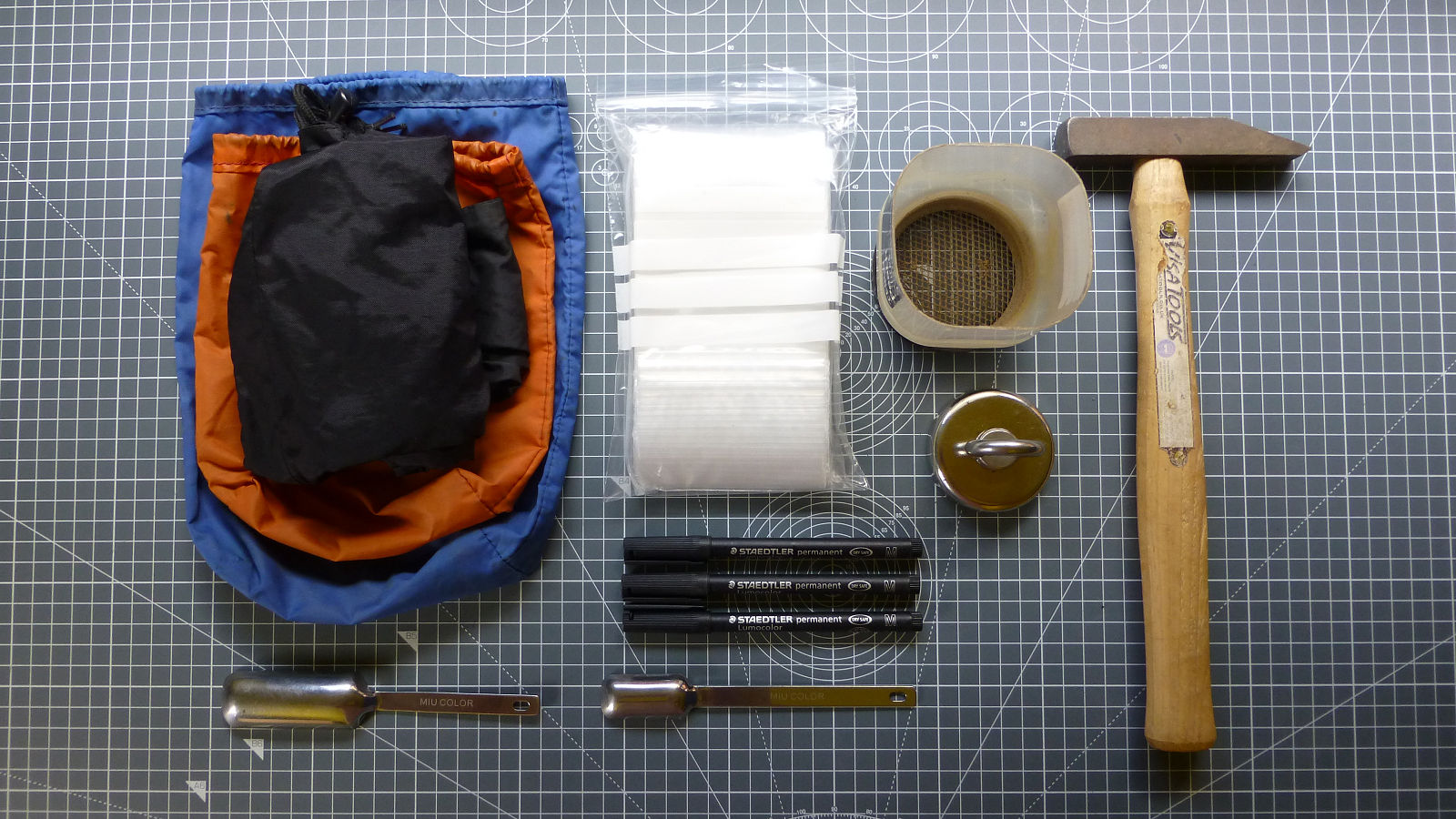What is sand collecting?
Sand collecting is a relatively inexpensive though often time-consuming pastime attracting an ever-increasing number of enthusiasts, known as Arenophiles, who share a passion for collecting small samples of sand, from beaches, rivers, dunes, streams, quarries and even landslides. The samples are then stored in clear bottles or similar containers for display and sometimes swapped or exchanged with other collectors around the world.
Why did you start collecting sand?
Since a very early age I’ve been interested in geology – rocks, minerals, fossils and the like, and simply decided one day to start collecting sand. Why? It costs very little although transport costs can soon mount up, it gets me outdoors in the fresh air exploring lots of new locations and there’s no end to how many different samples I can collect.
What do you enjoy most about sand collecting?
The thing that I enjoy most about sand collecting is actually getting out in the field and finding new samples. I must admit to sometimes getting rather excited when I come across unusual samples where you least expect them. It’s also a great feeling to return to the car with a bulging bag full of samples. often as many of 50 following a good day of collecting. I also enjoy seeing the samples all set out for drying in the shed.
Is collecting sand, for example, from a beach, legal?
Well, strictly speaking, removing sand from even a public beach, is probably illegal. Having said that, and unless you are using an excavator and taking lorry loads of the stuff, you are unlikely to have any problems, at least here in Scotland. The same applies to private land. Everything, even sand, is owned by someone, usually the landowner, although mineral rights can be a bit more complicated. The best advice I can give is, if in doubt, just ask. Permission is rarely refused. You may get some strange looks but you can handle it!
What is the purpose of this website?
This website was created to allow me to share my personal experience and knowledge of sand collecting, my passion for sand collecting and any useful hints and tips I come across and also to help promote the hobby of sand collecting to a wider audience. I also hope it will encourage others to take up this fine pastime.
Is it not a bit strange to collect sand?
Well, you do get some strange looks when you mention to people that you collect sand and you also get some equally strange looks when actually collecting in the field. If you are uncomfortable with this, just tell people you are collecting sand as part of a research study for your PhD in Palaeoarenology – the study of fossil sand – I made that one up! And yes, sand collecting is usually regarded as a rather strange hobby. Someone once thought I was a research scientist while collecting on the beach at St. Andrews in Fife one day!
Do you just collect sand?
Yes, mostly sand but also anything else that looks interesting and similar such as colourful clays, soils, silts and even mud, stone dust from quarries, coal dust from mine spoil heaps and even waste fuel ash from the filter ponds of a nearby coal-fired power station. In fact, anything similar to sand as long as it’s less than 2.00 mm in size. I also crush my own sand by collecting small samples of sandstone and similar rocks such as shale and crushing them to produce sand. I have even been known to collect a samples of peat, which is part way between soil and coal!
What equipment do you use?
My sand-collecting bag, actually an old canvas fishing tackle bag, holds an bundle of around 100 small self-seal polythene bags, a couple of kitchen measuring spoons, an assortment of stuff sacks bags and some permanent marker pens. I also carry a digital camera, along with spare battery and media card. On most trips I also carry a geology hammer for breaking sandstone to get fresh un-weathered samples, although usually I can find a suitable stone on location to do the same thing.
What size of sample do you collect?
When collecting sand I collect about half the volume of the 115 x 115 mm self-seal sample bags I use, more than I actually need to fill the 15 ml glass tubes I use for displaying my collection. This gives me an allowance for sieving out stones, organic matter (such as rabbit droppings!) and larger bits of shell, etc and for drying shrinkage and spillage. When collecting sandstone I make sure I have a sample, if possible, about the same size as golf ball. I must admit to finding it difficult not to collect too much and often find myself filling to sampling bag with far more than I really need.
How many samples do you collect?
That really depends on the type and size of the location but generally an individual location such as a beach might typically produce between 5 to 10 different samples. A sand and gravel pit might provide 10 samples, occasionally as many as 20. On average a good days collecting, taking in 5 to 8 locations would give me a collection of around 40 samples or so. If you also collect sandstone for crushing you could increase the above quantities considerably.
Where do you collect your samples?
I collect sand from beaches, dunes, rivers, gardens, streams, excavations, caves, mines, spoil heaps, sand and gravel pits, old landslides, quarries, mountains, the shores of ponds and lochs and anywhere else I come across sand, soil, clay or the like. My collecting is mostly restricted to south-east Scotland, including West Lothian, Midlothian, East Lothian and the Scottish Borders. However, I’m also collecting from a few of the neighbouring regions, such as the Kingdom of Fife, Dumfries & Galloway and over the English Border into Northumberland with future plans to travel throughout Scotland.
Is sand collecting expensive?
Generally speaking, sand collecting is not an expensive hobby as the material you collect is free. Equipment costs for consumables such as sampling bags and storage containers can vary widely and will really depend on what you purchase. Perhaps the most costly item would be travel – fuel costs soon mount up if you collect regularly from further away. For those who trade sand, you have postage and packaging costs to consider.
Would you like me to send you sand?
While that would be very kind of you, I’m only collecting sand that I can actually gather personally myself. So please do not send me sand. My personal opinion is that if you are going to collect anything you should actually collect it yourself.
How do you house your collection?
I display my sand samples in 15 ml volume, 25 x 50mm in size, glass tubes with press fit caps. Each has a printed label on the side describing the location and date. They are housed inside a 10 drawer steel filing cabinet. The tubes are laid flat for easy viewing. All my sand collection is kept in a large shed in the garden.
Do you have any samples to swap?
While I do collect more sand than required for display, I do not have any plans to exchange samples. As I only collect sand that I can physically collect myself, exchanging sand is not something I’m interested in doing. I do not keep any of the sand left over after the display containers have been filled.
What collecting guidelines do you follow?
There are three that I follow at the moment. One is that I only collect sand that I can gather personally in the field myself. The second is that I’m restricting my collection to sand samples from the British Isles, particularly Scotland and the North of England – essentially locations that are within a day drive. The third relates to the range of samples I collect, basically anything between fine silt and course sand.
Where can I learn more about sand collecting?
The first thing you might want to do is browse this website and read any of the pages that take your fancy. Next try a search on the Web for “sand collecting” or “sand collector” and see what turns up. There are quite a few web sites run by fellow sand collectors. Perhaps the best way to learn about sand collecting is to actually get out in the field and start collecting yourself!
Are there any books about sand collecting?
There are no published books on the subject of sand collecting that I’m aware of. However, that does not say one, or more, does in fact not exist. Your best bet would be to use Google and search the Web. Please let me know if you find anything.
Copyright ©2020 Gary Buckham. All rights reserved.


